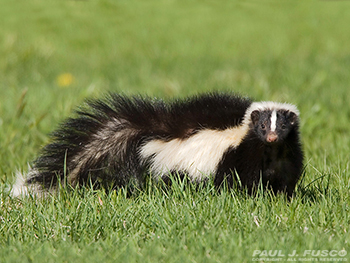Conflicts with Skunks
Management of Conflicts: Skunks are one of the most common sources of wildlife problems experienced by Connecticut homeowners. Skunks will dig up lawns and gardens searching for insect larvae and grubs. They leave cone-shaped, divet-like holes, three to four inches in diameter and may also turn over larger pieces of sod. Controlling lawn grubs may reduce skunk damage to lawns. Lawn treatment advice and materials are available from garden or hardware stores.
Turtle nests are also dug up by skunks searching for the eggs. Skunk predation on turtle eggs can account for a significant portion of egg mortality. Eggs of ground nesting birds will also be eaten if encountered by skunks.
Skunks will raid garbage cans for a variety of food scraps. Garbage cans should have tight-fitting lids and should be inaccessible to wild animals.
Skunks which have taken up residence under the porch or house can be excluded by covering all foundation openings with woven wire fencing. One opening should be left uncovered until no skunks remain under the building, such as when they have left to feed in the evening. This can be verified by seeing the skunks leave or flour can be sprinkled on the ground by this opening and checked periodically for footprints leading out of the opening. Once the skunk leaves, seal up the doorway with more fencing. You must be careful when using this technique since sealing burrows from early May to mid-August may leave young skunks trapped inside. Be sure all animals are out before sealing the final opening. Because skunks are adept at digging, any fencing may have to be buried at least one foot deep. Fencing will also help keep skunks out of gardens because they are not good climbers.
If a skunk happens to find its way into the basement or garage, leave a door open and let the animal come out on its own. To prevent future problems with skunks or other curious animals, keep basement and garage doors closed.
Skunks often become trapped in window wells. A flat, wide board placed at a low angle will usually allow the animal to climb out on its own.
Because skunks can carry rabies, they can no longer be live-trapped and relocated. Animals that appear sick or that are acting abnormally should be avoided. The following symptoms may indicate the presence of rabies or other neurological diseases in mammals: unprovoked aggression, impaired movement, paralysis or lack of coordination, unusually friendly behavior and disorientation. If you see this behavior, avoid the animal and notify your local animal control officer.
Do you need additional help and advice concerning nuisance wildlife? Check out www.wildlifehelp.org and select "Connecticut" as your state to get started. WildlifeHelp.org is supported by the Northeast Association of Fish and Wildlife Agencies and the Northeast Wildlife Damage Management Cooperative.
Content last updated on October 20, 2016.


